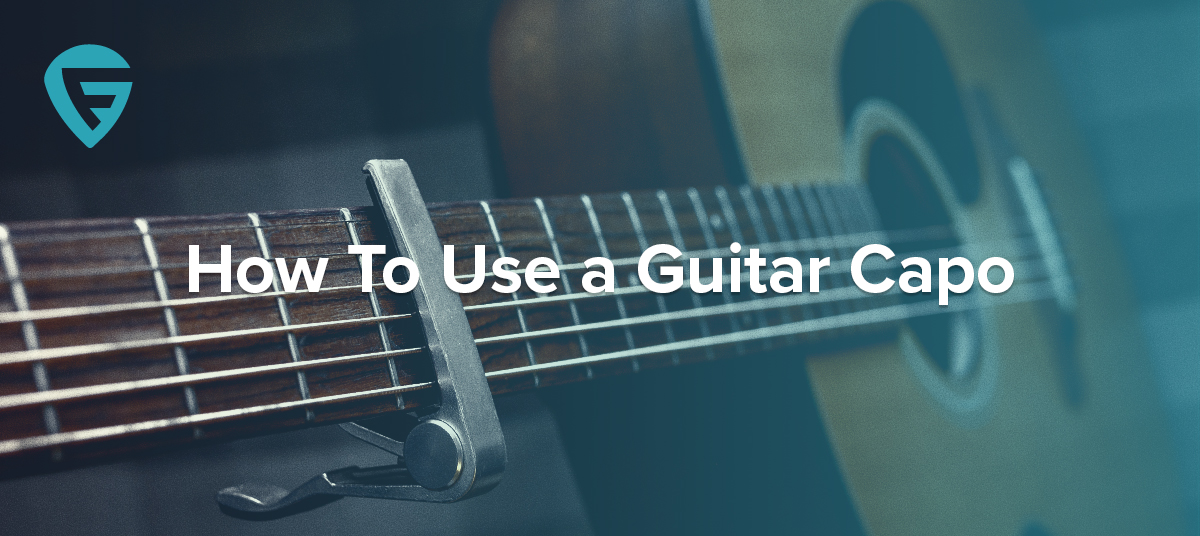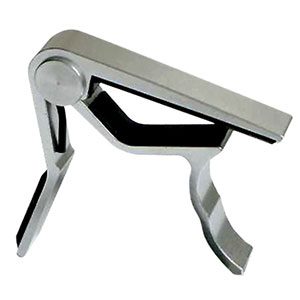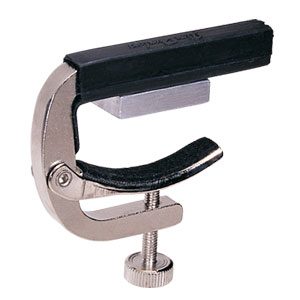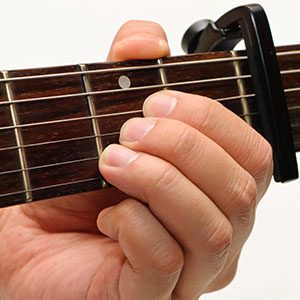- Home
- Instruments
- Gear
- Recording
- Lessons
- Reviews
- Blog

Guitar capos are an awesome little tool that really increases the practical potential of your guitar. If you’d like to learn more about different types of capos, check out our short guide right. With that out of the way, we can focus on the most important questions that can be asked when talking about guitar capos.
How do you use a guitar capo? That question requires a two-fold answer. In the first part, we will talk about how to actually mount various types of capos onto a six-string. The other part will cover how a capo actually changes the pitch of your guitar, and how you can use that to your advantage.
Use of a capo is really confusing to new guitar players. They are not yet fully familiar with basic music theory, which is something you definitely need to know if you plan on using a capo the right way. We won’t go too deep into music theory, but we will give you enough info for you to start using a capo with some level of understanding. With that said, let’s get on with it.
If you want to take this thing back to the start, feel free to check out our guide on What Is a Guitar Capo.
 The two most popular types of guitar capos you can find today are spring-loaded capos and c-clamp capos. The main difference between these two is the way they apply pressure on the strings. From a purely practical standpoint, spring loaded capos are easier to use and more versatile. To mount a spring loaded capo, all you have to do is compress the spring and put it on the neck at the fret of your choice. Spring loaded capos can be installed with just one hand, which makes them super practical especially if you need to install it quickly.
The two most popular types of guitar capos you can find today are spring-loaded capos and c-clamp capos. The main difference between these two is the way they apply pressure on the strings. From a purely practical standpoint, spring loaded capos are easier to use and more versatile. To mount a spring loaded capo, all you have to do is compress the spring and put it on the neck at the fret of your choice. Spring loaded capos can be installed with just one hand, which makes them super practical especially if you need to install it quickly.
On the other hand, c-clamps are more difficult to install but offer a much better and consistent performance. To install a c-clamp on your guitar, you first need to undo the screw-loaded mechanism and tighten it once the capo is mounted on the guitar.
 Since this screw dictates the amount of pressure you apply to the strings, it takes some finesse to find the correct setting. What tends to happen with both of these designs is string bending due to too much pressure. With c-clamp capos, you can easily adjust this, but that is not the case with spring loaded ones. That issue alone is definitely something you need to keep in mind.
Since this screw dictates the amount of pressure you apply to the strings, it takes some finesse to find the correct setting. What tends to happen with both of these designs is string bending due to too much pressure. With c-clamp capos, you can easily adjust this, but that is not the case with spring loaded ones. That issue alone is definitely something you need to keep in mind.
Now that you know how to mount your capo, the following matter arises – how to properly use it then? Read on for the answer!
 Just mounting a guitar capo is definitely just the first step in the whole process. Knowing how the capo affects your guitar is even more important. What we know already, and what is pretty obvious, is that a capo moves the open tuning of a guitar to a different pitch.
Just mounting a guitar capo is definitely just the first step in the whole process. Knowing how the capo affects your guitar is even more important. What we know already, and what is pretty obvious, is that a capo moves the open tuning of a guitar to a different pitch.
That means that your open E string will become an open G once you put a capo on the third fret of the fretboard. This allows you to play standard chord shapes and get a higher pitch, which is definitely not something you can do without a capo.
Changing a pitch this way is useful in several specific situations. Let’s say that you start jamming with a band and the singer starts singing in a key which you’re having trouble with. Instead of figuring out the chord progression for that song all over again, you can simply install the capo on the fret which matches the new key and play the chord progression you know. However, capo does a lot more for you than simply making your life as a guitarist easier.
 Adding a capo also has an impact on the sound of a guitar. It generally brightens up the tone, especially if you are playing with a band. If you apply the capo and change the key of the guitar, you can play the same chord as the other guitar player in the band, but yours will be in a higher pitch. Changing things a bit this way adds range and width to the overall sound of the band. Sometimes, it can be the missing factor that will give the song a completely new feel.
Adding a capo also has an impact on the sound of a guitar. It generally brightens up the tone, especially if you are playing with a band. If you apply the capo and change the key of the guitar, you can play the same chord as the other guitar player in the band, but yours will be in a higher pitch. Changing things a bit this way adds range and width to the overall sound of the band. Sometimes, it can be the missing factor that will give the song a completely new feel.
With all this stuff out of the way, we kindly invite you to check out our list of Best Guitar Capos on the market.
Guitar capos are an important piece of every guitar player’s gear. These simple and compact devices can definitely save you in a certain situation, while they can also give you an impressive amount of versatility if you know exactly how to use them.
The info we gave you in this article paints a good picture of how a capo should be used, and what it does to the tone of your instrument. We strongly suggest that you invest in a good capo if you plan on using it often. Even though c-clamp capos are a pain to mount and dismount, they are the best type out there. A c-clamp capo is worth both the extra effort and extra cost.
In the end, the type of capo you’re going to go for will depend on the type of application you have in mind for it. If you just need something to use from time to time during practice, a spring loaded capo will be more than fine.
However, the more serious your needs are, more serious capos will need to be considered. In general, you can find several models that are the go-to option right now and stick to them if you’re not comfortable experimenting.
Hopefully, this article helped you understand how capos are used, and what kind of options they give you as a guitar player. Rock steady, roll easy!

Reader Interactions